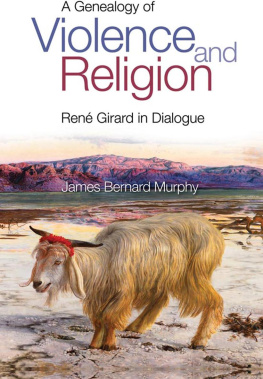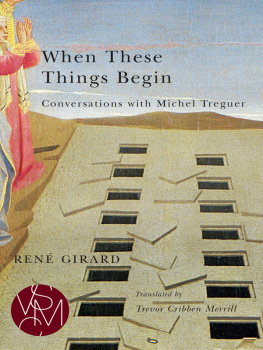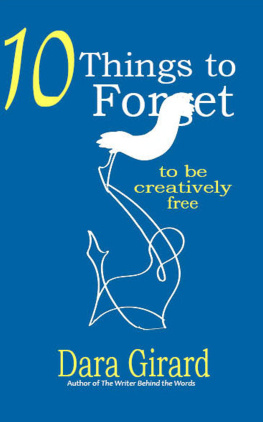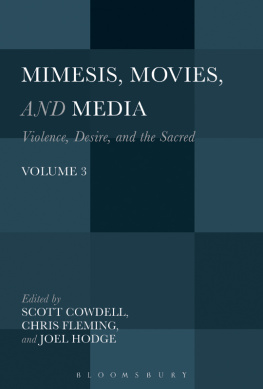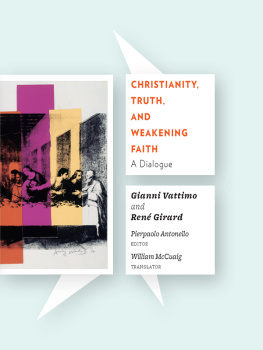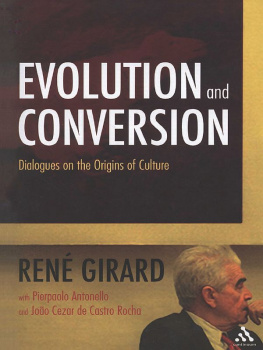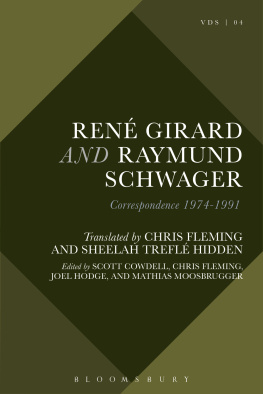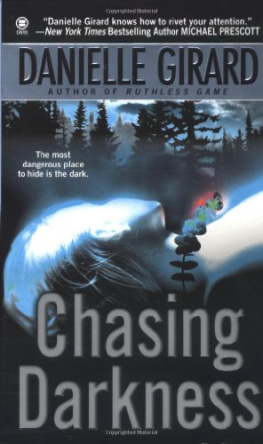Girard - Violence and the Sacred (Bloomsbury Revelations)
Here you can read online Girard - Violence and the Sacred (Bloomsbury Revelations) full text of the book (entire story) in english for free. Download pdf and epub, get meaning, cover and reviews about this ebook. year: 2013, publisher: Bloomsbury Publishing, genre: Romance novel. Description of the work, (preface) as well as reviews are available. Best literature library LitArk.com created for fans of good reading and offers a wide selection of genres:
Romance novel
Science fiction
Adventure
Detective
Science
History
Home and family
Prose
Art
Politics
Computer
Non-fiction
Religion
Business
Children
Humor
Choose a favorite category and find really read worthwhile books. Enjoy immersion in the world of imagination, feel the emotions of the characters or learn something new for yourself, make an fascinating discovery.

- Book:Violence and the Sacred (Bloomsbury Revelations)
- Author:
- Publisher:Bloomsbury Publishing
- Genre:
- Year:2013
- Rating:4 / 5
- Favourites:Add to favourites
- Your mark:
- 80
- 1
- 2
- 3
- 4
- 5
Violence and the Sacred (Bloomsbury Revelations): summary, description and annotation
We offer to read an annotation, description, summary or preface (depends on what the author of the book "Violence and the Sacred (Bloomsbury Revelations)" wrote himself). If you haven't found the necessary information about the book — write in the comments, we will try to find it.
Girard: author's other books
Who wrote Violence and the Sacred (Bloomsbury Revelations)? Find out the surname, the name of the author of the book and a list of all author's works by series.
Violence and the Sacred (Bloomsbury Revelations) — read online for free the complete book (whole text) full work
Below is the text of the book, divided by pages. System saving the place of the last page read, allows you to conveniently read the book "Violence and the Sacred (Bloomsbury Revelations)" online for free, without having to search again every time where you left off. Put a bookmark, and you can go to the page where you finished reading at any time.
Font size:
Interval:
Bookmark:
TITLES IN THE BLOOMSBURY REVELATIONS SERIES
Aesthetic Theory , Theodor W. Adorno
Being and Event , Alain Badiou
On Religion , Karl Barth
The Language of Fashion , Roland Barthes
The Intelligence of Evil , Jean Baudrillard
I and Thou , Martin Buber
Never Give In! , Winston Churchill
The Boer War , Winston Churchill
The Second World War , Winston Churchill
In Defence of Politics , Bernard Crick
Intensive Science and Virtual Philosophy , Manuel DeLanda
A Thousand Plateaus , Gilles Deleuze and Flix Guattari
Anti-Oedipus , Gilles Deleuze and Flix Guattari
Cinema I , Gilles Deleuze
Cinema II , Gilles Deleuze
Taking Rights Seriously , Ronald Dworkin
Discourse on Free Will , Desiderius Erasmus and Martin Luther
Education for Critical Consciousness , Paulo Freire
Marxs Concept of Man , Erich Fromm and Karl Marx
To Have or To Be? , Erich Fromm
Truth and Method , Hans Georg Gadamer
All Men Are Brothers , Mohandas K. Gandhi
Violence and the Sacred , Rene Girard
The Essence of Truth , Martin Heidegger
The Eclipse of Reason , Max Horkheimer
The Language of the Third Reich , Victor Klemperer
Rhythmanalysis , Henri Lefebvre
After Virtue , Alasdair MacIntyre
Time for Revolution , Antonio Negri
Politics of Aesthetics , Jacques Ranciere
Course in General Linguistics , Ferdinand de Saussure
An Actor Prepares , Constantin Stanislavski
Building A Character , Constantin Stanislavski
Creating A Role , Constantin Stanislavski
Interrogating the Real , Slavoj iek
Some titles are not available in North America.
Violence and the Sacred
Ren Girard
Translated by Patrick Gregory

Bloomsbury Academic
An imprint of Bloomsbury Publishing Plc
50 Bedford Square London WC1B 3DP UK
1385 Broadway New York NY 10018 USA
www.bloomsbury.com
Bloomsbury is a registered trade mark of Bloomsbury Publishing Plc
First published in 1988 by The Athlone Press
English translation 1977 by The Johns Hopkins University Press. All rights reserved
Originally published in Paris in 1972 as La Violence et le sacre 1972 by Editions Bernard Grasset
Bloomsbury Revelations edition first published in 2013 by Bloomsbury Academic
All rights reserved. No part of this publication may be reproduced or transmitted in any form or by any means, electronic or mechanical, including photocopying, recording, or any information storage or retrieval system, without prior permission in writing from the publishers.
No responsibility for loss caused to any individual or organization acting on or refraining from action as a result of the material in this publication can be accepted by Bloomsbury Academic or the author.
British Library Cataloguing-in-Publication Data
A catalogue record for this book is available from the British Library.
eISBN: 978-1-4725-3002-8
Contents
My thanks are due to the Guggenheim Foundation for the fellowship, and to the State University of New York at Buffalo (Faculty of Arts and Letters) for the sabbatical leave that enabled me to complete the present book. I wish to express my appreciation to Martine Bell, not only for typing and proofreading but also for her thoughtful examination of the manuscript and bibliographical materials and a careful preparation of the index. My gratitude also goes to all my friends, and especially to Eugenio Donato and Josue Harari, whose constant collaboration and numerous suggestions have been extremely helpful.
In many rituals the sacrificial act assumes two opposing aspects, appearing at times as a sacred obligation to be neglected at grave peril, at other times as a sort of criminal activity entailing perils of equal gravity.
To account for this dual aspect of ritual sacrificethe legitimate and the illegitimate, the public and the all but covertHenri Hubert and Marcel Mauss, in their Essay on the Nature and Function of Sacrifice, adduce the sacred character of the victim. Because the victim is sacred, it is criminal to kill himbut the victim is sacred only because he is to be killed. Here is a circular line of reasoning that at a somewhat later date would be dignified by the sonorous term ambivalence. Persuasive and authoritative as that term still appears, it has been so extraordinarily abused in our century that perhaps we may now recognize how little light it sheds on the subject of sacrifice. Certainly it provides no real explanation. When we speak of ambivalence, we are only pointing out a problem that remains to be solved.
If sacrifice resembles criminal violence, we may say that there is, inversely, hardly any form of violence that cannot be described in terms of sacrificeas Greek tragedy clearly reveals. It has often been observed that the tragic poets cast a glimmering veil of rhetoric over the sordid realities of life. True enoughbut sacrifice and murder would not lend themselves to this game of reciprocal substitution if they were not in some way related. Although it is so obvious that it may hardly seem worth mentioning, where sacrifice is concerned first appearances count for little, are quickly brushed asideand should therefore receive special attention. Once one has made up ones mind that sacrifice is an institution essentially if not entirely symbolic, one can say anything whatsoever about it. It is a subject that lends itself to insubstantial theorizing.
Sacrifice contains an element of mystery. And if the pieties of classical humanists lull our curiosity to sleep, the company of the ancient authors keeps it alert. The ancient mystery remains as impenetrable as ever. From the manner in which the moderns treat the subject of sacrifice, it would be hard to know whether distraction, detachment, or some sort of secret discretion shapes their thinking. There seems to be yet another mystery here. Why, for example, do we never explore the relationship between sacrifice and violence?
Recent studies suggest that the physiology of violence varies little from one individual to another, even from one culture to another. According to Anthony Storr, nothing resembles an angry cat or man so much as another angry cat or man. If violence did indeed play a role in sacrifice, at least at one particular stage of the ritual, we would have a significant clue to the whole subject. Here would be a factor to some extent independent of those cultural variables that are often unknown to us, or only dimly known, or perhaps less familiar than we like to think.
Once aroused, the urge to violence triggers certain physical changes that prepare mens bodies for battle. This set toward violence lingers on; it should not be regarded as a simple reflex that ceases with the removal of the initial stimulus. Storr remarks that it is more difficult to quell an impulse toward violence than to rouse it, especially within the normal framework of social behavior.
Violence is frequently called irrational. It has its reasons, however, and can marshal some rather convincing ones when the need arises. Yet these reasons cannot be taken seriously, no matter how valid they may appear. Violence itself will discard them if the initial object remains persistently out of reach and continues to provoke hostility. When unappeased, violence seeks and always finds a surrogate victim. The creature that excited its fury is abruptly replaced by another, chosen only because it is vulnerable and close at hand.
Next pageFont size:
Interval:
Bookmark:
Similar books «Violence and the Sacred (Bloomsbury Revelations)»
Look at similar books to Violence and the Sacred (Bloomsbury Revelations). We have selected literature similar in name and meaning in the hope of providing readers with more options to find new, interesting, not yet read works.
Discussion, reviews of the book Violence and the Sacred (Bloomsbury Revelations) and just readers' own opinions. Leave your comments, write what you think about the work, its meaning or the main characters. Specify what exactly you liked and what you didn't like, and why you think so.

